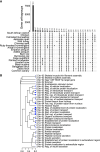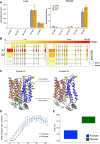Genomic insights into metabolic flux in hummingbirds
- PMID: 37156619
- PMCID: PMC10317124
- DOI: 10.1101/gr.276779.122
Genomic insights into metabolic flux in hummingbirds
Abstract
Hummingbirds are very well adapted to sustain efficient and rapid metabolic shifts. They oxidize ingested nectar to directly fuel flight when foraging but have to switch to oxidizing stored lipids derived from ingested sugars during the night or long-distance migratory flights. Understanding how this organism moderates energy turnover is hampered by a lack of information regarding how relevant enzymes differ in sequence, expression, and regulation. To explore these questions, we generated a chromosome-scale genome assembly of the ruby-throated hummingbird (A. colubris) using a combination of long- and short-read sequencing, scaffolding it using existing assemblies. We then used hybrid long- and short-read RNA sequencing of liver and muscle tissue in fasted and fed metabolic states for a comprehensive transcriptome assembly and annotation. Our genomic and transcriptomic data found positive selection of key metabolic genes in nectivorous avian species and deletion of critical genes (SLC2A4, GCK) involved in glucostasis in other vertebrates. We found expression of a fructose-specific version of SLC2A5 putatively in place of insulin-sensitive SLC2A5, with predicted protein models suggesting affinity for both fructose and glucose. Alternative isoforms may even act to sequester fructose to preclude limitations from transport in metabolism. Finally, we identified differentially expressed genes from fasted and fed hummingbirds, suggesting key pathways for the rapid metabolic switch hummingbirds undergo.
© 2023 Gershman et al.; Published by Cold Spring Harbor Laboratory Press.
Figures




References
-
- Baker HG, Baker I, Hodges SA. 1998. Sugar composition of nectars and fruits consumed by birds and bats in the tropics and Subtropics1. Biotropica 30: 559–586. 10.1111/j.1744-7429.1998.tb00097.x - DOI
Publication types
MeSH terms
Substances
LinkOut - more resources
Full Text Sources
Miscellaneous
